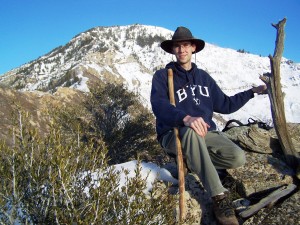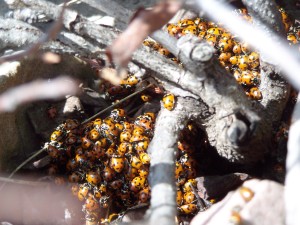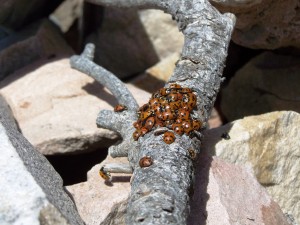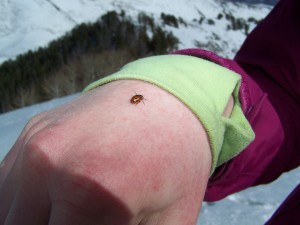I never realize how hard winter is on me until it begins to end. The first warm day in spring where I begin to notice the budding trees and sprouting plants. Its like I peel off a dry husk that has grown over me during the winter and awake from a dream of ice skates, short days spent in endless hours on computer screens, frozen sidewalks, and dark nights. As the clouds begin to lift my eyes very quickly check the summits still shrouded in winter. How long before I can begin climbing again? I’ll try a few hikes to lower destinations realize its too soon then retreat back into the deserts which don’t close in the winter and can be quite pleasant in the spring. But I can feel the mountains calling, even as the spring flowers break out of their own winters’ sleep, inviting me upwards to the summits.
Hypsotactic. My usual dictionary is useless for this one. I find the more focused my interests get the less useful the general dictionary is. Google can’t help me either, it keeps trying to correct the spelling. Okay, time for the primary literature. The papers give contextual definitions “connected with prominent isolated and contrasting objects visually present in relatively dry situations“. I try again and end up with the somewhat simpler definition “attracted to and moving towards prominent objects on the horizon”. Why do I bring this up? Well, ladybugs are attracted to mountains also.
In an effort to get my hiking season started early one year I determined to hike a large but overlooked mountain in the nearby range. While Buckley Peak is taller than its neighbors it is dwarfed by the ridge line behind it. It lacked the distinct cliffs and urban art that decorated the smaller peaks and as a result there was no trail to the summit. Being early in the season the mountain consisted of grassy slopes, still-sleeping scrub oak, and a cap of snow. After seven hours of bushwhacking, bouldering, and squishing through snowfields we made the summit and were delighted to find a sunny, dry patch of rocks sticking out of the snow. It was here on top of the mountain that I discovered thousands of ladybugs.
They were gathered in thick clumps, crawling about, not eating, not flying, just hanging out like convention goers between sessions. We were at 9000 feet, in March, on a mountain peak mostly covered in snow. What on earth were ladybugs doing climbing mountains? I unleashed my curiosity online. Hippodamia convergens, or the convergent lady beetle, is very common in the United States and is well documented to seek out mountain summits as a place to spend the winter. Indeed, collectors will often visit these places of congregation (called hibernacles) in order to capture large quantities to sell as biocontrols on the overpopulous aphids which frequently infest rose bushes. Ok, so ladybugs do this intentionally. Lots of animals migrate as a means of dealing with winter. But why are these adorable little beetles are migrating to colder, harsher environments in the winter?
There are a few theories about the behavior although the scholars seem unconvinced by any of them. First off there are other species of lady beetle that do it, in Asian and Europe at least. that’s where that word comes in, hypsotactic. They think the lady beetles fly towards whatever object is most prominent on the horizon which is how they all end up at the same mountain peak. They do this in the fall before it gets too cold to fly (they can’t fly when it is colder than about 54 F) and food supplies start to get low. But they migrate from a place where there is little food to a place where there is no food. Plus, it gets cold on mountains, and in the winter it stays cold for a long time. The cold-blooded lady beetles would be trapped until the mountains warm enough for them to fly again, well after the valley floors are warm and productive again.
It’s possible that the lady beetles are gathering to mate, by congregating from over a large area they can mix genetics quite nicely. Except, they only mate sometimes. Other times they fly back to the valley and mate there. Also, not all lady beetles migrate to mountain tops. Some (perhaps the near-sighted ones) will congregate in leaf litter or under logs and spend their winter there. One theory was that some of the parasitic fungus that can kill them can’t live at the high elevation; except it can. It’s possible that they go up there to avoid predation, figuring that if its hard for lady beetles to live up there it must be hard for their predators also. But no one has proven that one yet either.
I imagine the behavior must be ingrained in them. A ladybug emerges from the egg to a nice warm world filled with sugary aphids to eat. As a child I watched the black larvae gorging themselves on the little green bugs that filled my mother’s rose bushes. Eventually they get big enough to metamorphize into a full red-coated adult. Now with the gift of flight they flutter around hunting for more aphids, maybe some pollen, or perhaps another ladybug so they can lay another bunch of eggs. Those eggs may hatch that same year and another generation will proliferate in the warm sunny world. Then, without ever having experienced it themselves, they somehow know winter is coming.. They turn towards the horizon and look for shadows, for something tall. Instead of short flights they fly up into the wind currents and travel as much as 37 miles a day. They congregate in their mountaintop hibernacles where they huddle together and use stored fat to survive the winter (even ladybugs can be fat).

When spring finally comes to the mountaintop they scatter. It doesn’t seem to be a homing behavior, where they return to the place where they came from. They just sort of all wander wherever. They start looking for food and eventually make their way down the mountain back to the aphid-laden rose bushes, like those in my mother’s garden.
Maybe they climb mountains to escape from predators or parasitic fungus. Maybe they do it to exchange ideas with each other or meet potential mates. Maybe some of us just have to get away from the pressure of eating sugar bugs on a bed of roses now and then. Maybe they have to go on their own spirit quest where they search out the edge of survival in order to better understand the nature and purpose of life. Or maybe, and perhaps probably, they have no idea why they get that irresistible urge to fly towards the highest point that overlooks their world, they just do it.







Maybe…
If I’m a lady bug, I can hibernate. When I’m hibernating, I don’t need any food. I won’t starve. When it warms up a little bit, I can no longer sleep so I get hungry. If I’m on the valley floor when I wake up, there’s no food to be had, because I’m very picky about only eating aphids, so I starve. But if I’m on a mountain top when it finally gets warm enough, the aphids down below are already fat and juicy. I just flap a bit and let the wind take me to Rosy’s diner.